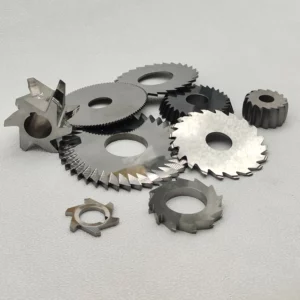Tabla de contenido
PalancaCarbide Tipped Blade
Choosing the right tools for metalworking is essential for achieving the best results and consistently high-quality finishes. Among these tools, the carbide tipped blade for metal cutting stands out as a top choice for both professionals and DIY enthusiasts. These blades are renowned for their durability, efficiency, and precision. However, selecting the appropriate carbide tipped blade for your specific application might seem daunting. In this article, we will explore the key factors to consider when making this choice, the benefits these blades offer, and the various applications where they shine.
Understanding Carbide Tipped Blades
At its core, a carbide tipped blade features cutting edges made from high-quality carbide, a material that combines carbon with a metal to create a hard, wear-resistant tool. This composition allows carbide tipped blades to retain sharpness longer than their traditional counterparts, leading to improved performance and longer service life. When cutting metal, this advantage translates to cleaner cuts, reduced friction, and lower heat generation, resulting in less contamination or warping of the material.
For example, a contractor cutting aluminum sheets with a standard steel blade might experience dullness after just a few cuts, leading to jagged edges and potentially requiring additional finishing work. In contrast, using a carbide tipped blade for metal would allow that same contractor to finish the job with smooth edges, saving both time and money in the long run.
Selecting the Right Blade for Your Application
When it comes to choosing a carbide tipped blade for metal cutting, several factors must be taken into account:
1. Material Type: Different types of metal require specific blade features. For instance, stainless steel, aluminum, and mild steel have varying properties; hence, the cutting blade needs to be tailored accordingly. A blade designed explicitly for stainless steel may have fewer teeth and a unique tooth geometry to prevent binding and ensure efficient cutting. If you’re cutting aluminum, a blade with a higher tooth count that creates a smoother finish would be ideal.
2. Blade Diameter: The diameter of the blade is crucial for both the type of saw you are using and the type of cut you want to achieve. A larger blade diameter can handle deeper cuts, while a smaller diameter is suitable for precision cuts and navigating tighter spaces. For instance, if a manufacturer needs to cut thick steel plates, a 14-inch carbide tipped blade would be more appropriate than a smaller 10-inch blade.
3. Teeth Configuration: The arrangement and number of teeth on a blade significantly influence its cutting ability. Fewer teeth generally result in faster cuts, while more teeth produce smoother finishes. Consequently, a contractor cutting heavy-duty steel beams might choose a blade with fewer, stronger teeth to make quick cuts, while someone working with sheet metal might opt for a blade with more teeth to ensure a perfected, finished edge.
4. Kerf Width: The kerf is the width of the cut made by the blade. A thin kerf blade will remove less material and reduce cutting resistance, making it ideal for applications where precision is paramount. Conversely, a thicker kerf blade can be more robust and handle tougher cuts but may lead to more material wastage. When cutting intricate architectural metalwork, for instance, a thin kerf carbide tipped blade for metal can prevent unattractive cut lines and minimize the need for post-cut refinishing.
Benefits of Carbide Tipped Blades
Beyond their impressive performance, carbide tipped blades for metal offer numerous benefits that customers should be aware of:
Increased Longevity: These blades are designed to resist wear and tear, allowing for longer usage periods between replacements. This durability translates into reduced costs in the long term, making carbide tipped blades a smart investment for anyone regularly cutting metal.
Precision Cutting: With their superior design and quality materials, carbide tipped blades enable cleaner cuts with precise edges. This characteristic is particularly beneficial in applications requiring high accuracy, like metal fabrication for aerospace or automotive components.
Reduced Heat and Friction: The construction of carbide tipped blades leads to lower heat generation during cuts, which helps in prolonging the blade’s lifespan and preventing warping of the metal pieces being cut. For example, when working on wiring and electrical panels, less heat minimizes the risk of melting surrounding insulation materials.
Áreas de aplicación
The versatility of carbide tipped blades for metal cutting extends to numerous fields, making them indispensable in various sectors:
Construction: Contractors frequently use carbide tipped blades for cutting steel studs, beams, and other structural components. Their durability ensures that tools remain effective even after extensive use.
Manufacturing: In factories, metal cutting blades are essential for creating parts that fit together precisely. Equipment like saws with carbide tipped blades become more efficient, leading to improved production timelines.
Home Improvement: For DIY enthusiasts, having a carbide tipped blade on hand translates to a wealth of possibilities—whether it’s crafting custom furniture or renovating old metal fixtures around the house.
Automotive: Mechanics often require blades to cut through parts made from different metals. Carbide tipped blades help them make quick, clean cuts, ensuring they can meet tight repair deadlines.
In summary, choosing the right carbide tipped blade for metal cutting involves understanding your specific needs based on material types, blade diameter, tooth configuration, and kerf width. The benefits of longevity, precision, and reduced heat make these blades an appealing option for various applications – from construction and manufacturing to DIY projects at home. As you consider your next cutting project, remember that selecting a high-quality carbide tipped blade for metal isn’t just about the cut itself; it’s about investing in your tools for future efficiency and quality. By prioritizing informed choices, you’ll enhance your capabilities and achieve outstanding results in all your metalworking endeavors.
